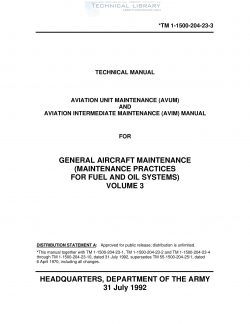ARMY-TM-1-1500-204-23-3
- Version
- 224 Downloads
- 1.30 MB File Size
- 1 File Count
- March 5, 2017 Create Date
- March 5, 2017 Last Updated
Maintenance Practices for Fuel and Oil Systems - Vol. 3

1-1. PURPOSE. This volume provides general infor- mation pertaining to the maintenance practices for fuel and oil systems. Specific maintenance practices are found in the individual aircraft maintenance manuals. This volume is of maximum benefit to the mechanic who desires information about fuel and oil identification, con- tamination, handling, storage, and fuel and oil system maintenance. This volume furnishes the mechanic a source of information about how to perform various me- chanical functions which are used on all aircraft. This volume is not a requisitioning authority, and applicable repair parts and special tool lists should be consulted to obtain the unit of issue and Federal Stock Number of the items required for maintenance.
2-1. GENERAL. The fuel system supplies fuel to the carburetor or fuel control under all conditions of ground and air operation. Identification, contamination, and general maintenance practices will be covered in this chapter. 2-2. SAFETY PRECAUTIONS AND PROCEDURES. The safety precautions and procedures below are only minimum requirements for average conditions. All per- sonnel who are required to service, maintain, or repair fuel systems should observe the precautions described in the following paragraphs. a. Fuel Lines and Drains. Keep all fuel vents and drains clean and open. b. Tools. Use only sparkproof hand or air power tools in the maintenance of fuel systems. c. Tool Boxes. Rubber wheeled tool boxes inside the fuel cell repair area shall be bonded to the aircraft and grounded. Tool boxes, except those mounted on rubber wheels, shall remain outside the fuel cell repair area. Tools required to perform maintenance shall be hand-carried to the aircraft in nonmetallic containers, such as cardboard boxes or canvas bags. Tool boxes locked and secured in storage racks need not be re- moved from the fuel cell repair area providing they re- main locked and in the storage racks.
| File | Action |
|---|---|
| ARMY-TM-1-1500-204-23-3 Maintenance Practices for Fuel and Oil Systems - Vol. 3.pdf | Download |

Comment On This Post